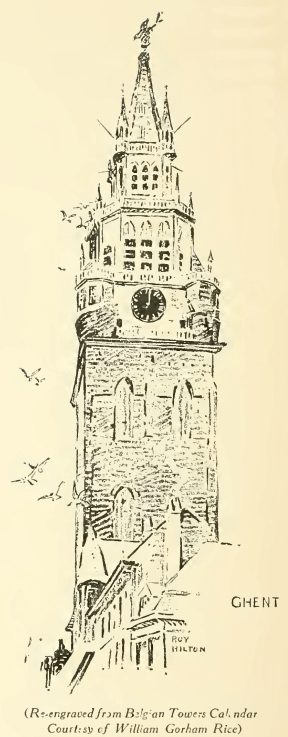The Washington Peace Carillon
A Brochure Issued by Lovers of the Bells and Dedicated to Others ofTheir Kind. Done in the Interest of a Greater Washington.

Ghent
Whose carillon of 52 bells has given joy to many thousands. InDecember, 1814, these bells rang out at the signing of the treaty ofpeace between the United States and Great Britain, and but for theoutbreak of the great war, would in 1914 have celebrated the completionof a hundred years of unbroken peace between the two nations.
A PEACE CARILLON[*]
By
J. Marion Shull
Silent are the church towers of Flanders and Artois, the belfries ofDouai and Bruges. They have been robbed of their treasures, thosebells that for hundreds of years have pealed forth the hopes andaspirations of the surrounding countryside. These bells have suffereddesecrations, their noble metal recast for purposes of war and theirerstwhile melodious tongues constrained to speak the raucous tones ofbattle in behalf of barbarian hosts. But now that it is within ourpower let us give them back to civilization. From the metal ofcaptured enemy cannon let there be cast the most wonderful carillonof bells of which the world's best makers are capable, and let thesebe duplicated in sufficient numbers that the capital city of each ofthe great allied nations may be provided with a set of these "peacebells."
The architects of all the world would vie with one another to see thatin each of these cities should arise a magnificent bell tower to housethis carillon, a splendid example of fitting architecture, worthy ofthe theme commemorated. No doubt, some modern Giotto would emerge togive the world a masterpiece in stone, which would gather to itselftradition from the past and build tradition for the years to come.Incorporate within its walls, perhaps, some block from shattered Rheims,from Amiens and Arras; another from the ruined treasures of Louvain, andso perpetuate the glory of those sacred heaps of stone now tumbled inconfusion by the ruthless hand of hate. Then, too, some village onthe Marne, where first the invading hosts were halted and turned back,might honor thus and in its turn be honored by one memorial stone inthis great monument to peace.
Bells have been cast from cannon in the past. More than two hundredyears ago, in 1710, the Emperor Joseph I, of Austria, had a great bellcast from Turkish cannon and placed in the tower of St. Stephen's atVienna. This, known as the emperor bell, weighed seventeen tons.But this, although it symbolized a triumph of the Christian over theTurk, was also meant to glorify the emperor's military might. Itspoke of insolent pride, not peace and good will, and furnished anexample for Emperor William in 1873. Read now the arrogantinscription that winds in three encircling lines about thislater emperor bell, so named in honor of Emperor William, who had itcast from twenty cannon taken from the French in 1870, and hung inthe tower of Cologne Cathedral. The original is in Latin, but istranslated thus:
"William, the most illustrious Emperor of Germany and King of Prussia,in pious remembrance of the heavenly aid granted him in the fortunatecourse and conclusion of the last French war, has ordered, after therestoration of the German empire, a bell to be cast from the capturedcannon, of the weight of 50,000 pounds, which is to be suspended in thehouse of God, now nearly completed. In accordance with this piousdesire of